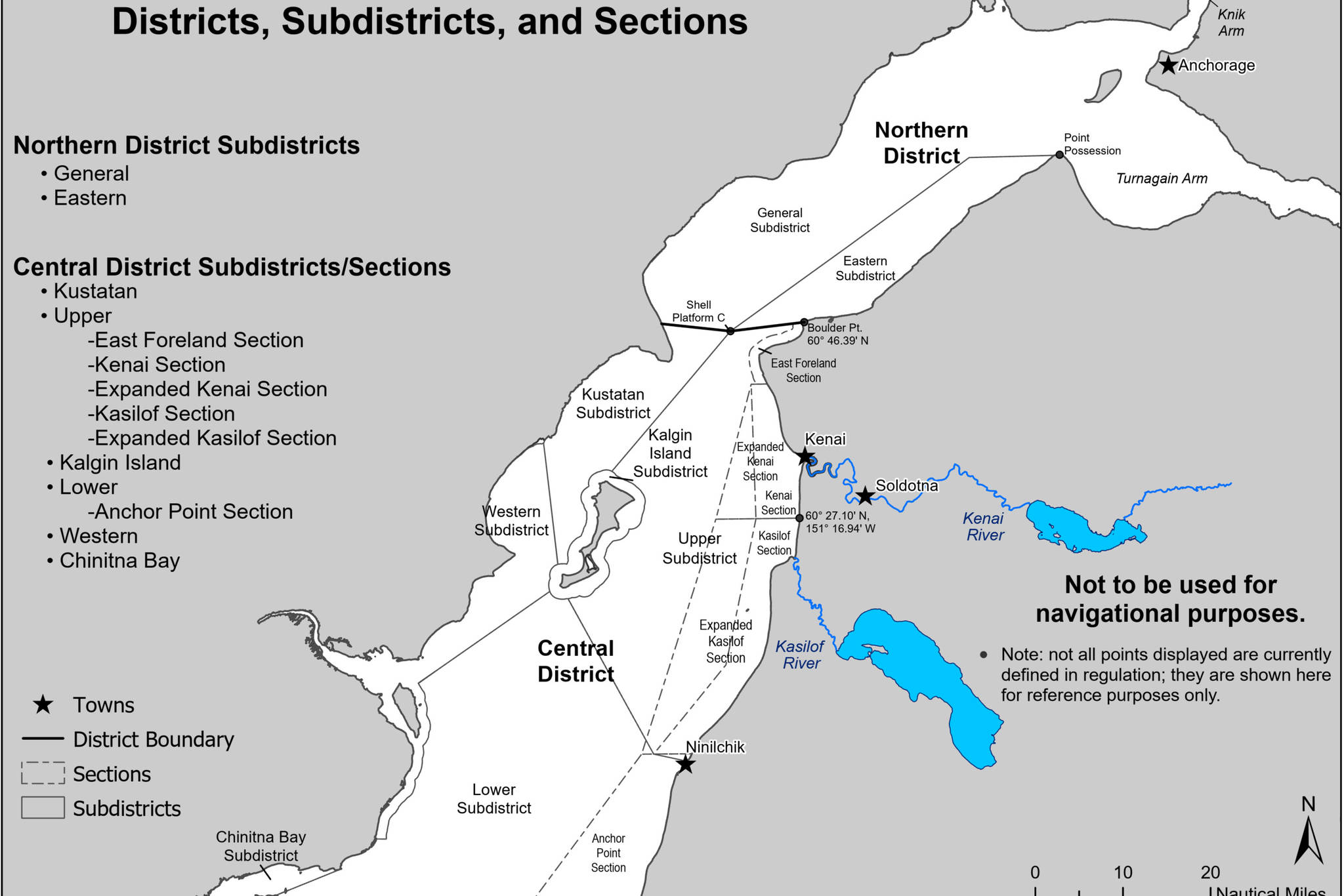The Alaska Board of Fisheries voted Tuesday to adopt two proposals that will tighten restrictions on the Central District Drift Gill Net Fishery in the Upper Cook Inlet in an attempt to allow more salmon to reach the northernmost parts of Cook Inlet.
While meeting in Anchorage to discuss proposed regulatory changes to the Upper Cook Inlet Fin Fish Fisheries, the Board voted to adopt Proposals 124 and 133, both of which amend the Central District Drift Gill Net Fishery Management Plan in different ways.
Proposal 133
Proposal 133 eliminates the option for fishery managers to, between July 16 and July 31, expand one 12-hour fishing period from Drift Gill Net Area 1 to a district-wide fishing period in years when the Kenai River has a sockeye salmon run of greater than 2.3 million fish.
It also adds mandatory restrictions to drift gill netting from Aug. 1 to Aug. 15 that limit the regular Monday and Thursday fishing periods to the following areas: Expanded Kenai Section, Expanded Kasilof Section, Anchor Point Section and Drift Gill Net Area 1.
All additional fishing time from Aug. 1 to Aug. 15 other than the regular fishing periods will be limited to the following areas: Expanded Kenai Section, Expanded Kasilof Section and Anchor Point Section.
The proposal was introduced by the Mat-Su Borough Fish and Wildlife Commission.
Board member John Wood, of Willow, said on Tuesday that the proposal addresses a need in the Matanuska-Susitna Valley to deal with low returns in the area for sockeye and coho salmon. Wood said that strengthening the conservation corridor in this way would lead to more fish in the Susitna drainage system that can be available for all user groups.
A majority of the coho salmon caught in the corridors that would be restricted by the proposal, Wood said, are fish that are bound for the Susitna drainage system.
“If you want to help the Susitna rehabilitate those streams, this is the tool to do so,” Wood said.
Board member Israel Payton, of Wasilla, noted that the proposal would likely reduce the harvest of commercial drift gill net fisheries.
“Yes, we are allocating away from a certain fleet: commercial users, drift fleet,” Payton said. “I’m fully aware of that. That doesn’t bring me any joy.”
Board member John Jensen, of Petersburg, was the sole vote against the proposal.
Proposal 124
Proposal 124 amends the preamble of the Central District Drift Gill Net Fishery Management Plan to read (changes in italics):
“The purpose of this management plan is to ensure adequate escapement and a harvestable surplus of salmon into the Northern District drainages and to provide management guidelines to the department. The department shall manage the commercial drift gill net fishery to minimize the harvest of Northern District salmon and Kenai River coho salmon in order to provide all users a reasonable opportunity to harvest these salmon stocks over the entire run, as measured by the frequency of in-river restrictions. The department shall manage the Central District Commercial drift gill net fishery as described in this section.”
The proposal adds “and a harvestable surplus” to the first sentence, adds the word “salmon” after “Northern District” in the second sentence and replaces “Sport and guided sport fisherman” with “all users” in the second sentence.
Payton said that ADF&G has stated in their reports to the Board that the language in the preamble of management plans does not affect in-season fishery management, but rather acts as a guide for both the Board and Department to indicate long-term goals. Payton also said that he felt the current preamble language was inadequate.
“What it does is basically give the targets, what’s the purpose of the plan,” Payton said. “And then the tools (for management) fall under the plan. And I think for many years the preamble language in the current plan wasn’t working.”
Payton said that the new language reflects the intent of the newly adopted restrictions in Proposal 133 and “enshrines” it into the stated goals of the Board.
Board members who were opposed to Proposal 124 argued that the language changes were too vague and would not impact the Board’s future decision-making in a substantial way.
“I think that bringing Northern District users together is a noble goal, but I think this is what our job is generally, that of the department and the management plan,” Board member Fritz Johnson, of Dillingham, said. “To provide escapement and you know, god willing, there will be a harvestable surplus as a result, but it just kinda seems superfluous in my eyes, adding verbiage that we don’t really need.”
Proposal 124 narrowly passed the board by a vote of 4-3 after being amended with substitute language.
The Board will continue to discuss proposed changes to their management plans until Tuesday, Feb. 18.
A live audio stream is available on the Board’s website when they are in session, and full audio of the meetings are posted online after they take place.
All information pertaining the Upper Cook Inlet Finfish Meetings can be found on the Board’s website, including all public comments and supporting documents.


